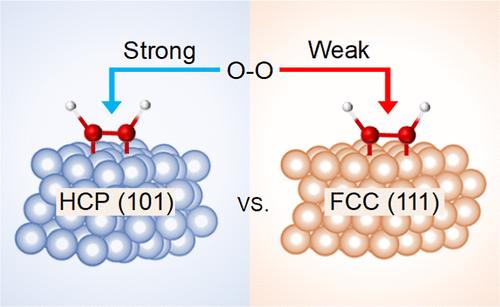HCP-to-FCC Phase Transformation of Ruthenium Nanocrystals Selectively Activate Hydrogen Peroxide for Boosting Peroxidase-like Activity
IF 16
1区 材料科学
Q1 CHEMISTRY, MULTIDISCIPLINARY
引用次数: 0
Abstract
Due to the simultaneous activation of hydrogen peroxide (H2O2) and oxygen, Ru nanocrystals exhibit inherent peroxidase- and oxidase-like activities, thereby limiting their extensive application in biosensing. Phase engineering of Ru nanocrystals holds great promise for enhancing catalytic activity and selectivity but remains a challenge. Here, highly active Ru nanocrystals with a metastable face-centered cubic (fcc) structure were successfully synthesized via a facile wet-chemical method followed by an etching step, enabling selective activation of H2O2 and demonstrating promising peroxidase-like activity. Compared to the thermodynamically favored hexagonal close-packed Ru nanocrystals, the resultant fcc Ru shows an over 5-fold enhancement in the maximum reaction velocity of the peroxidase-like catalysis, while its oxidase-like performance exhibits a minor decline, indicating a transition from multienzyme activity to specificity. Theoretical calculations reveal that the phase transformation of Ru not only results in an upward shift of the d-band center to enhance H2O2 adsorption but also regulates the O–O bonding strength of H2O2 to achieve selective H2O2 activation. As a proof of concept, a colorimetric sensor based on fcc Ru nanocrystals was successfully constructed, achieving accurate and sensitive detection of organophosphorus pesticides. This work not only offers promising prospects for phase engineering of Ru nanocrystals but also highlights the significance of the Ru phase transition in hydrogen peroxide activation.

钌纳米晶体hcp - fcc相变选择性活化过氧化氢提高过氧化物酶样活性
由于过氧化氢(H2O2)和氧的同时激活,钌纳米晶体表现出固有的过氧化物酶和氧化酶样活性,从而限制了其在生物传感中的广泛应用。钌纳米晶体的相工程在提高催化活性和选择性方面具有很大的前景,但仍然是一个挑战。本研究通过简单的湿化学方法和蚀刻步骤成功合成了具有亚稳面心立方(fcc)结构的高活性Ru纳米晶体,使H2O2能够选择性活化,并显示出有希望的过氧化物酶样活性。与热力学上有利的六方密排Ru纳米晶体相比,fcc Ru的类过氧化物酶催化的最大反应速度提高了5倍以上,而类氧化酶的性能略有下降,表明了从多酶活性到特异性的转变。理论计算表明,Ru的相变不仅使d波段中心上移,增强了对H2O2的吸附,而且调节了H2O2的O-O键强度,实现了H2O2的选择性活化。作为概念验证,成功构建了基于fcc Ru纳米晶体的比色传感器,实现了对有机磷农药的准确灵敏检测。这项工作不仅为Ru纳米晶的相工程提供了良好的前景,而且突出了Ru相变在过氧化氢活化中的意义。
本文章由计算机程序翻译,如有差异,请以英文原文为准。
求助全文
约1分钟内获得全文
求助全文
来源期刊

ACS Nano
工程技术-材料科学:综合
CiteScore
26.00
自引率
4.10%
发文量
1627
审稿时长
1.7 months
期刊介绍:
ACS Nano, published monthly, serves as an international forum for comprehensive articles on nanoscience and nanotechnology research at the intersections of chemistry, biology, materials science, physics, and engineering. The journal fosters communication among scientists in these communities, facilitating collaboration, new research opportunities, and advancements through discoveries. ACS Nano covers synthesis, assembly, characterization, theory, and simulation of nanostructures, nanobiotechnology, nanofabrication, methods and tools for nanoscience and nanotechnology, and self- and directed-assembly. Alongside original research articles, it offers thorough reviews, perspectives on cutting-edge research, and discussions envisioning the future of nanoscience and nanotechnology.
文献相关原料
公司名称
产品信息
阿拉丁
Tetramethylbenzidine
阿拉丁
oleylamine (OAm)
阿拉丁
Molybdenum carbonyl (Mo(CO)6)
 求助内容:
求助内容: 应助结果提醒方式:
应助结果提醒方式:


